May 2021
May 21, 2021
Field Umbrella
Patent No. 2,320,848 was granted to Hollie Lee Byars of Parrish, Alabama for an umbrella designed to protect people stooped over. She imagined it would be useful for field workers. Although anyone who spent a lot of time hunched over could benefit.There have been times when I've been weeding my yard that I could have used something like this.

Posted By: Alex - Fri May 21, 2021 -
Comments (3)
Category: Inventions, Patents, 1940s, Weather
Vapo Path
Creosote and naphthalene! My favorite medicines!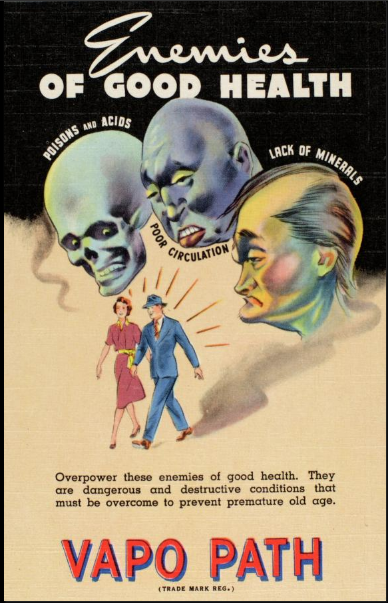
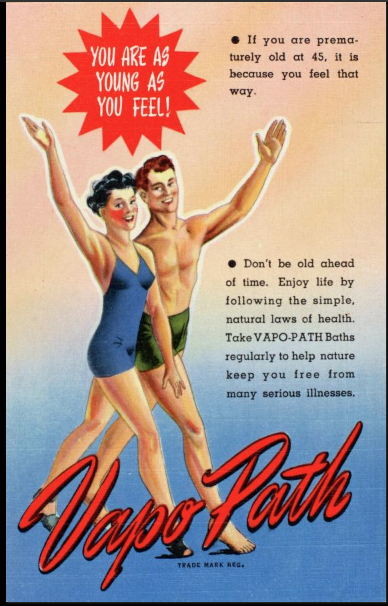
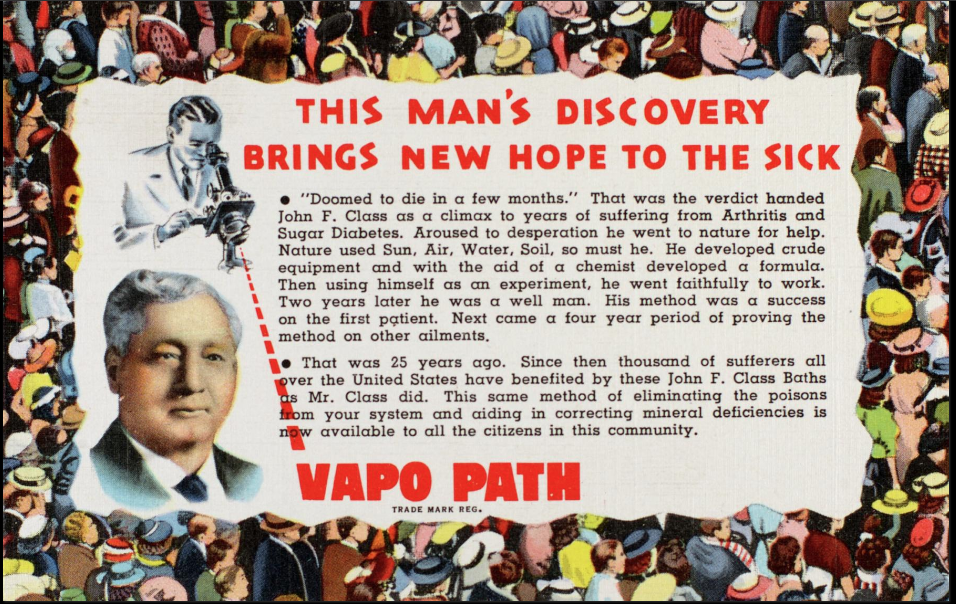
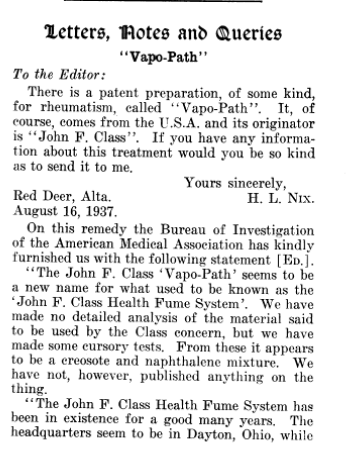
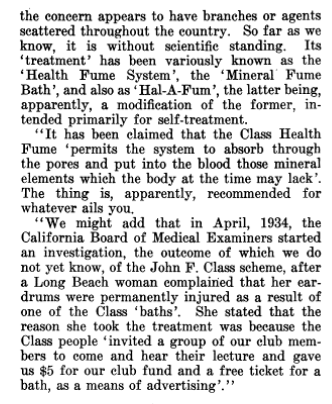
Posted By: Paul - Fri May 21, 2021 -
Comments (2)
Category: Patent Medicines, Nostrums and Snake Oil, 1930s, 1940s
May 20, 2021
Art-Necko Ties
Minnesota artist Mark Larson debuted his line of Art-Necko ties in 1978. These were plastic, see-through ties, and the gimmick was that he filled them with various stuff.
source: flickr
As described in the Minneapolis Star Tribune (Nov 26, 1978):
The neon tie, however, is the current front-runner. Larson's favorite, it's a stunning red-and-blue creation that makes a glowing statement about the wearer—providing he's hooked up to a power source.
And these have nothing on the proposed ties. There could be—well, the world's loudest tie (armed with a tiny loudspeaker to broadcast jets taking off); the horror movie or Vincent Price model (containing dry ice, with tiny holes in the front to permit the wearer to trail wisps of fog); the Fit-to-be-Tied Tie (a self-inflating strait-jacket that takes over when you feel you are losing control), and the chow mein tie, inspired by the Seal-a-Meal machine that is basic to the Art-Necko process.

The cowboy tie
People magazine (Jan 15, 1979) listed a few more:
Fishing Tackle features Goldfish crackers, a hook, sinker and a rubber worm. Vanity contains false eyelashes and phony fingernails. And for the ghoulish, there's Bones—scrubbed and boiled shortribs.
At the time the Art-Necko ties sold for $10. I found one for sale on eBay for $14.66. So not much increase in value in the past 40 years.
Posted By: Alex - Thu May 20, 2021 -
Comments (2)
Category: Art, Fashion, 1970s
Seleno, the Electric Dog
Read the amazing story of cyber-pup here!ADDENDUM: the link is down as of mid-day May 20, but since the site is a longstanding page, I assume the outage is temporary and am leaving the link in place.
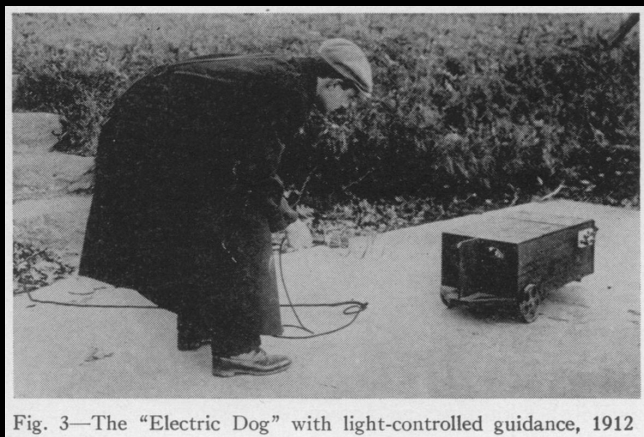
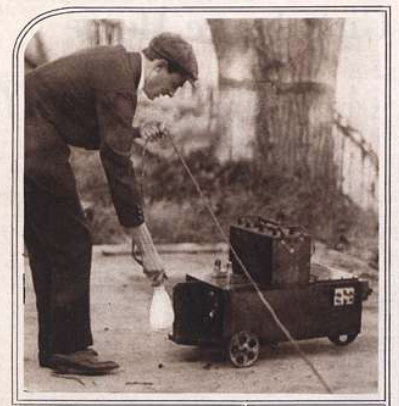
Posted By: Paul - Thu May 20, 2021 -
Comments (1)
Category: Inventions, Robots, 1910s
May 19, 2021
Blood drips from ceiling
News that could be in a horror story: Down in El Paso, Texas, Ana Cardenas was recently woken by something dripping on her face. She turned on her light and discovered it was blood. And blood was also splattered on her walls.Turned out a man in the apartment above had died (of natural causes) and the blood from his decomposing body had eventually made its way through the floor into Cardenas's bedroom. Her ceiling fan was splattering the blood as it dripped into her room.
Posted By: Alex - Wed May 19, 2021 -
Comments (6)
Category: Death, Horror
Odyssey: Into the Mind’s Eye
1990s production of psychedelic trip with soundtrack.
Posted By: Paul - Wed May 19, 2021 -
Comments (0)
Category: Drugs, Psychedelic, Music, Special Effects, 1990s
May 18, 2021
The Golden Gate Bridge Bolt
In 1937, the city of San Francisco was busy preparing for the upcoming 1939 Golden Gate International Exposition when it was was approached by an engineer from Connecticut, Joseph Bazzeghin, who had an unusual proposal. He wanted to use the recently completed Golden Gate Bridge as a structure upon which to build the ultimate roller coaster, which he would call the Golden Gate Bridge Bolt. He envisioned this coaster being the centerpiece of the exposition, in the same way that the Eiffel Tower was the centerpiece of the 1900 Paris Exposition.
Image source: CA State Archives Newsletter
His plan involved attaching tracks to the cables of the bridge. These tracks would rise 300 feet above the first tower, and then drop 750 feet to the deck level of the center span — during which plunge the coaster would reach a speed of 190 mph. But then it would rise up again, 300 feet over the second tower, only to plunge 1000 feet toward the water and speed through a viaduct into Marin County.
During the second plunge riders would reach 220 mph, at which speed the force of the wind would make it impossible for them to breathe. So Bazzeghin planned to provide them with paper masks to protect their eyes, nose, and mouth.
His scheme was rejected, partially because the city was worried about drivers on the bridge being distracted by the sight of the roller coaster. But also because it would have been incredibly expensive, and possibly impossible, to build.
More info: CBS SF BayArea, SF Chronicle
Posted By: Alex - Tue May 18, 2021 -
Comments (3)
Category: Architecture, Fairs, Amusement Parks, and Resorts, 1930s
Follies of the Madmen #507
Lecherous donut wants new franchisers.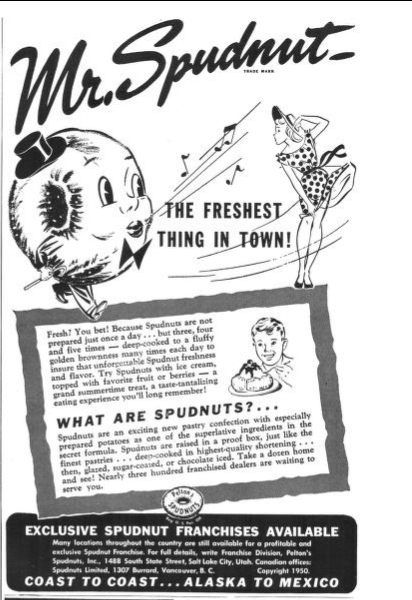
Posted By: Paul - Tue May 18, 2021 -
Comments (1)
Category: Anthropomorphism, Business, Advertising, Food, 1950s
May 17, 2021
Eviction caused bad breath, dandruff
1979: After being evicted from the townhouse he was renting, R.L. Ussery filed a lawsuit against his former landlord seeking $11,000 in compensation. Ussery claimed that the eviction had caused him and his family to suffer from "colds, nausea, upset stomach, diarrhea dysentery, loss of hair, sweating palms, the need to void, the inability to void, nightmares, insomnia, dandruff, bad breath, dirty fingernails, odoriferous body odors, especially of the feet, palm itching, the blues and the blahs, nervousness, dry heaves and crying spells."I don't know what the result of the lawsuit was, but I think it's highly unlikely that Ussery won.

Tampa Tribune - Aug 24, 1979
Posted By: Alex - Mon May 17, 2021 -
Comments (1)
Category: Lawsuits, 1970s
The Inventions of Russell Oakes
An article here.
Posted By: Paul - Mon May 17, 2021 -
Comments (0)
Category: Humor, Inventions, Rube Goldberg Devices, 1940s
| Get WU Posts by Email | |
|---|---|

| Who We Are |
|---|
| Alex Boese Alex is the creator and curator of the Museum of Hoaxes. He's also the author of various weird, non-fiction books such as Elephants on Acid. Paul Di Filippo Paul has been paid to put weird ideas into fictional form for over thirty years, in his career as a noted science fiction writer. He has recently begun blogging on many curious topics with three fellow writers at The Inferior 4+1. Chuck Shepherd Chuck is the purveyor of News of the Weird, the syndicated column which for decades has set the gold-standard for reporting on oddities and the bizarre. Our banner was drawn by the legendary underground cartoonist Rick Altergott. Contact Us |

